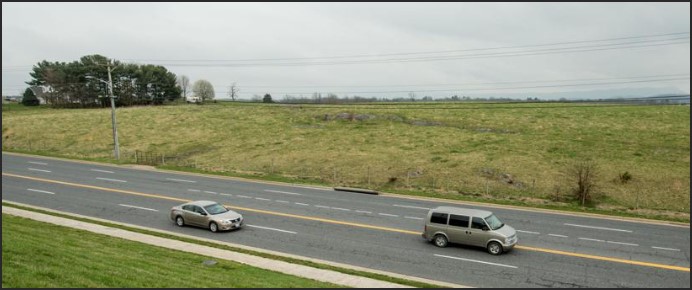
Land across from Harrisonburg High School is the site of a proposed 1,000 unit housing development. Photo credit: Daily News-Record
by Joe Fitzgerald
On the website for a proposed 1,000-unit housing development in Harrisonburg is a description of the players in the project. Included is a history of sorts of the Harrisonburg Redevelopment and Housing Authority:
“[A] local election was held on November 8, 1955 and a majority of those voting in the election approved the need for a Redevelopment and Housing Authority to be activated in the City.”
The next sentence says HRHA helps people with their rent today. You’d almost think nothing had happened in the ensuing 67 years.
Sure, there was the time HRHA destroyed the city’s Black business section to build a Safeway and a Rose’s. And the time the authority partnered with the city and county to raze a couple of city blocks downtown to build a jail. There was the theatre that had to be bailed out by the city and the community center renovation that had to be bailed out by the city. (Full disclosure, I voted for the first bailout when I was on City Council and knew the second would have to happen when I voted for the renovation.)
It’s not that HRHA has a checkered history. It just happens to be the agency the city has often used for projects that are off the city’s books, until they’re not.
Now the agency is spearheading a project that will aim to solve or at least mitigate the city’s perceived housing crisis, with promises that it will not raise city taxes or provide housing opportunities to anyone but current city residents.
The scheme involves creating a “town center” far from the center of town. To the untrained eye, the artist’s renderings of the site look like a huge apartment complex. It will make housing affordable to more people, and will be made affordable to the HRHA-owned company through the use of tax credits.
If you go to the site on Google maps instead of to the company’s website, you’ll see a cow pasture dotted with rock. Perhaps striped with rock, depending on your artistic sensibilities. The same kind of limestone has added the annual real estate taxes of you, me, and several hundred of our neighbors to the cost of Rocktown High.
The rock is likely one reason no private builders have put houses there. The larger question is why builders haven’t put houses elsewhere in the city. One answer, critics might say, is builder greed, which the builders might defensibly call fiduciary responsibility or the need to make a buck. That leads us to the question of why they can’t make a buck building in the city.
One reason is the tax credits are difficult to get, if you qualify. That’s why the HRHA partner in the company specializes not in construction, housing, or community planning, but in tax credits. Another reason is that it’s expensive to build in Harrisonburg because of the city’s building standards and fees. Even the builder I’ve asked about those fees isn’t sure how much they sum to. Waiving or reducing some of those fees and requirements might encourage private builders.
The city has added a housing coordinator recently, and a liaison committee between HRHA and city government. It’s not clear what role, if any, that coordinator has in this project, or whether this project will make the position unnecessary. It is also not known if the city council has already coordinated or liaised with HRHA about this project, or whether any informal discussions have occurred about rezonings and permits.
One reason I’m concerned about this project is the impact on city schools. We’ve broken ground on five new schools in the last two decades, excluding HHS, which replaced an existing school. My own estimates of new students range from 400 to 2,000. Nobody knows what that number is and, surprisingly, nobody is required to figure it out before building. They do have to conduct a traffic report, and the abbreviation for the assessment, TIA, is the same as the one for a mini-stroke. That is not, let us hope, a metaphor for the stress this development will bring to the city.
The chair of the HRHA board has promised that the people moving into the new complex will come from elsewhere in the city. That leaves open the question of who’ll move into the homes and apartments they move out of. But nobody in the city government or HRHA is required to address that issue. Nobody was required to address it when developers over-built housing for college students, and families with K-12 students moved into the older apartments.
There’s a meeting at the Sims Community Center Tuesday, June 7, at 4 p.m. It’s part of what looks like a public relations blitz to counter rising resistance from the potential neighbors of the complex. The minimal website for the project is part of that same blitz.
The tax impact is just one way to measure what the complex will do to the city. It could add as much as 40% to the city’s real estate tax, although that’s a worst case. The stress can also be measured in personnel terms. The HPD is down by more than 15% and the school system just had one of its biggest retirement events in several years. Those organizations need to rebuild after COVID. The impact of the “town center” complex will not be immediate, but neither will that rebuilding.
HRHA and its partner need a rezoning for the field of rocks where they plan to build. There’s a multi-step process for that to happen, but in reality three votes on city council can override any of those steps.
This project feels like a rock rolling downhill. I hope I’m wrong.
Joe Fitzgerald lives in Harrisonburg. This column has been republished with permission from Still Not Sleeping.


